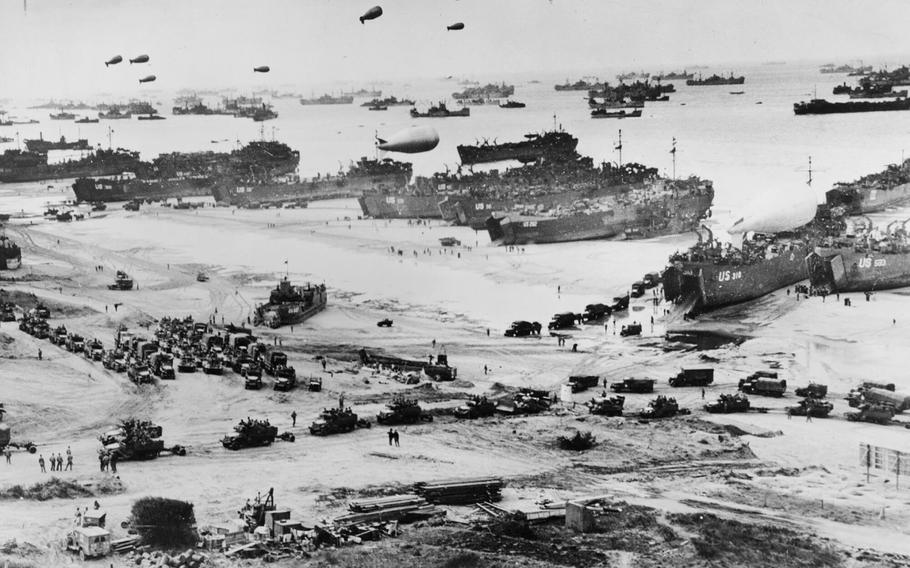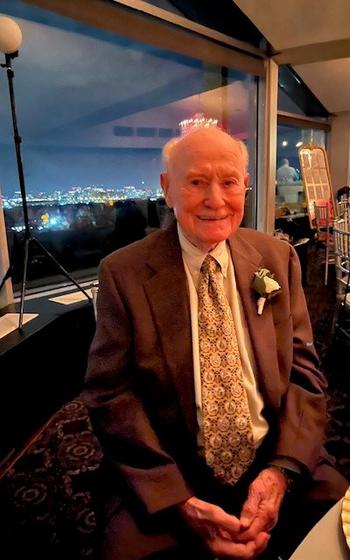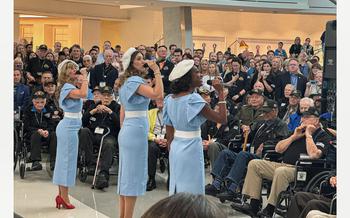
A bird’s-eye view of Allied troops landing in Normandy, France, on D-Day, June 6, 1944. (National Archives)
DALLAS — When Robert Pedigo steps off a plane Saturday in Paris to attend ceremonies marking the 80th anniversary of the D-Day landings, it will be the first time the 100-year-old veteran of the Normandy invasion has ever set foot on French soil.
His war was fought in the air over France and Germany as a nose gunner and chief armorer on a B-24J “Liberator” bomber, part of the 453rd Bombardment Group based northeast of London.
The Indianapolis native is among about 60 World War II veterans traveling to France to attend the June 6 ceremonies with a group organized by American Airlines. The veterans — average age just over 100 years — will be joined on the pilgrimage by about 230 others including medical personnel, U.S. service academy cadets, Medal of Honor recipients from other wars, relatives, attendants and others.
Each of the veterans, regardless of the role that they played in the defeat of fascism or where they served, has a story to tell, adding to the understanding of a conflict that saved democracy and shaped the modern world at the cost of an estimated 419,000 American lives worldwide.
Despite the horrific losses suffered by the U.S. and its allies on D-Day — an estimated 4,414 Allied troops died, including 2,501 Americans on June 6, 1944, alone — Pedigo describes his experience that day as the easiest of his 30 combat missions. They included raids on Berlin, Munich and eight other German cities.
“We attacked a German troop concentration near St. Laurent (on D-Day),” he said. “We caught the Germans by surprise, and the targets were destroyed.”

Martin Sylvester, an infantryman with the 4th Infantry Division during the Normandy Campaign in World War II, is among veterans planning to return to France for the 80th anniversary of the D-Day invasion. (Courtesy of Paul Sylvester)
Another member of the group, Brooklyn-born Martin Sylvester, 99, saw the war from a different perspective. An infantryman with the 12th Regiment, 4th Infantry Division, he came ashore at Utah Beach on the second day of the invasion, walking past wrecked equipment and a few bodies of German defenders.
“The French people were so happy to see us,” Sylvester told Stars and Stripes. “The women came out and gave us hugs and kisses, bottles of wine. We were like celebrities.”
Sylvester and Pedigo’s experiences were common for men and women of that era — children of the 1930s depression whose lives were upended by a war fought in strange-sounding parts of the world that they barely understood.
Sylvester, whose parents owned a dry-cleaning business in the Crown Heights section of Brooklyn, was drafted out of his freshman year at Brooklyn College soon after his 18th birthday and ended up in the infantry after basic training in Alabama.
Later, an older brother was killed in the Battle of Huertgen Forest, where Martin Sylvester also fought but in a different unit.
World War II veteran Robert Pedigo, left, shakes hands with former Vice President Mike Pence in March at a ceremony in Indianapolis marking National Medal of Honor Day. Pedigo will be attending ceremonies in Normandy marking the 80th anniversary of the D-Day landings, in which he took part as a crew member of a B-24J Liberator bomber. (Photo courtesy of Jill Fewell)
Pedigo worked at a factory manufacturing the top-secret Norden bombsight but enlisted even though his job would have probably qualified him for a draft deferment. His airplane, dubbed the “Silent Yokum” after a popular cartoon character, was rushed to the 453rd Bombardment Group a few weeks before the invasion because the unit had recently lost eight planes in a raid over Braunschweig, Germany.
On the afternoon before D-Day, his group operations officer, the actor Jimmy Stewart, marched the squadron into a field away from the buildings so no unauthorized persons could hear him.
“Fellas, we have a big mission coming up,” Pedigo recalls Stewart saying. “I want you to get some sleep.”
Hours later, Pedigo and his crew were flying over the English Channel.
“The whole channel was full of ships, so many of them it seemed like you could walk to France stepping on one boat after another,” he said.
For Sylvester, word of the invasion came in the form of a barracks guard rousting the men before dawn.
“They woke us up at 2:30 a.m. and told us to get ready to leave,” he said. His only clue of what lay ahead was an order to take full backpacks “so we knew we wouldn’t be coming back.”
Flying a large group of elderly veterans from the Dallas-Fort Worth International Airport to Paris and then transporting them to and from Normandy — nearly 200 miles each way from the French capital — is no mean feat.
U.S. soldiers hold French and U.S. flags during the 78th anniversary of D-Day ceremony at the Normandy-American Cemetery and Memorial of Colleville-sur-Mer on June 6, 2022. The ceremonies pay tribute to the nearly 160,000 troops from Britain, the United States, Canada and elsewhere who landed on French beaches on June 6, 1944, to restore freedom to Europe after Nazi occupation. (Jeremias Gonzalez/AP)
The veterans will attend commemorative ceremonies in the Paris area, visit Omaha and Utah beaches where U.S. forces came ashore, and take part in the main event at the Normandy American Cemetery along with President Joe Biden, French President Emmanuel Macron and other dignitaries on June 6.
“It’s really a logistical challenge,” said David Seymour, chief operating officer of American Airlines who grew up in a military family. “It’s something we would want to do as an organization. It’s really about recognizing those who served and preserving their stories” before it’s too late.
The upcoming commemoration may well be the last with significant numbers of World War II veterans. According to the National Museum of World War II, an estimated 119,550 of the 16.4 million Americans who served in that conflict were still alive at the end of 2023.
An average of 131 World War II veterans dies each day, according to the Department of Veterans Affairs.
Seymour said planning for the D-Day pilgrimage began after American Airlines flew a group of veterans to Hawaii in 2021 for the 80th anniversary of the Japanese attack on Pearl Harbor, which propelled the United States into the war.
The airline worked with the Old Glory Honor Flight group, which flies veterans to Washington, and the National Museum of World War II in New Orleans, the Gary Sinise Foundation, the State Department, the Department of Veterans Affairs, the French government and others to put together the trip.

The singing group Victory Belles from the National Museum of World War II perform before veterans preparing to travel from Dallas to France with American Airlines to attend D-Day commemorations in Normandy. (Robert H. Reid/Stars and Stripes)
Planning included identifying eligible veterans, medical screening to make certain that they were physically able to make the trip — including a nine-hour flight from Dallas to Paris — and arranging for individual escorts to attend to each person’s needs.
“It involved about 18 months of intensive planning,” Seymour said. “The 80th anniversary of D-Day will be a huge event. You can imagine every hotel in the area will be fully booked. We had to work with the (U.S.) Embassy and the Secret Service because the president will be there.”